Ella Montt’s experiment of planting and harvesting at the Allotment Plot at MERL is on going. The first harvest (on 20/05/2010), which was over wintered Spinach, was inedible. The Spinach should have produced leaves that would have been harvestable through out the months of winter. The Spinach suffered crop failure and was regrettably dug up on 27/05/2010 to make way for new plants. The fork used to extract the Spinach had great difficulty in root excavation, because the soil was so dry and compact. The discarded plants were placed in a wheelbarrow to be delivered later to a compost bin in order for the molecular break down into soil.
The Brassicas look like they are also doomed to crop failure, but as part of the experiment in planting and harvesting, the striped seedlings will be left for a duration of weeks in order to monitor their progression and as a Monument to crop failure. The experiment here is to test the plants will and determination for growth and survival. Replanting of these particular Brassica seeds is not really an option, because their planting window was March to April and it is now the end of May. The summer Spinach that was planted in March is also going to seed.
On 26/05/2010 it had rained during the night. The rainwater had wet the surface soil, but not penetrated further into the ground. More rain is needed. The ground is desperately dry. However, the evidence of other plant proliferation diffuses a sense of desperation regarding specific elemental conditions that have resulted in particular crops failure.
A handful of Peas (2oz or 40grams) was harvested. More will be ready soon. The Broadbeans are forming and some will probably be ready for harvesting next week, providing no hungry predators attack the young pods.
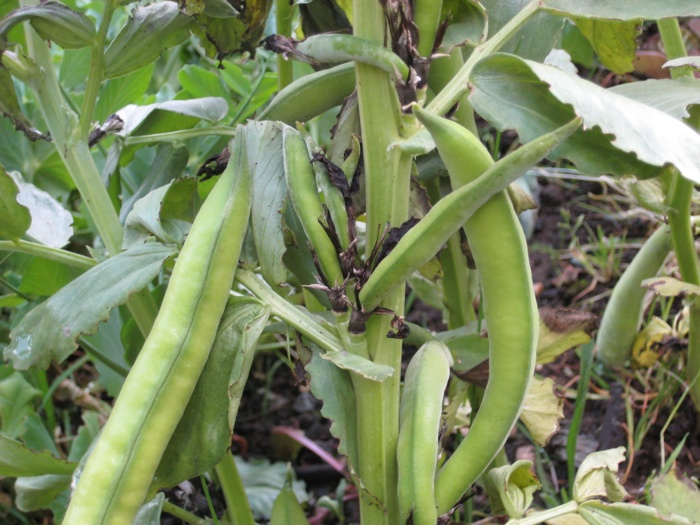
The next action on the Allotment Plot involved planting. The area that had held the over wintered Spinach between the Peas and the Garlic, was commandeered for the Squashes. Ten holes were dug with a trowel in readiness for the new plants. Various Squashes had been germinated and grown on as seedlings in the fixed up greenhouse at another location. The seeds that had had been planted weeks before in the greenhouse included Cucumber Tanja, Courgette Patriot F1, Courgette Soliel F1, Squash Black Futsu, Squash Green Hokkaido, Squash Uchiki Kuri, Squash Blue Ballet, and Squash Butternut. On moving the plants to MERL a breakdown occurred in Ella Montt’s transcribing communication structure resulting in confusion by Ella Montt as to which plant was which variety. Therefore an assortment of Squashes was planted on the Plot, ten plants initially, but depending on the success or failure of the planting, these may be followed by others. After the plants arrived in their growing destination and their roots were covered a bell was rang to announce their arrival. The plants were shocked and wilting after their travel from the greenhouse to the Plot. They were given water, poured from the watering can, to aid their recovery.
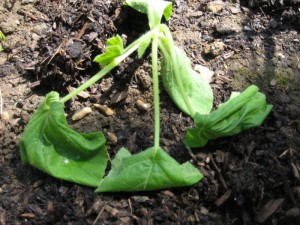
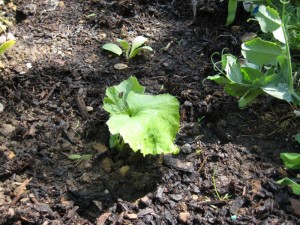
Next holes were dug in the Brassica area near to Sunflowers and Garlic, six Tomato plants; one Pepper and one Aubergine were planted. a bell was rung to announce the new plant arrivals and the plants were watered. Sticks are forced into the ground to act as support for the plants as they grow. String was tied around the sticks and each plant.

Another planting action then took place, in the herb border next to the Sage and Chives. Young herb seedlings were planted including Marjoram, Camomille and Basil.
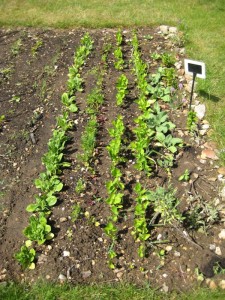

A report on the other crops not previously mentioned on the Plot is as follows: Parsnips, Carrots, Onions, Red Onions, Red Kale are all growing. Leeks, Rainbow Chard and Beetroot are growing, but very small. Sunflower plant is growing and Sunflower seeds are germinating, (predators please stay away from the area).
The Garlic plants are developing central looping stalks know as Scape, these can be snipped off and eaten after they have made one or two loops. Or they can be cut before the loop progresses to try to insure a larger bulb. The Scape can be left until harvest time; the flower will produce Bulbils that is Garlic seed, which can be used to plant to grow more Garlic next year. The Garlic Scapes will be left to grow as an experimental part of the Plot. The Scapes will be cut at different times and the Garlic bulbs monitored as part of the harvesting.
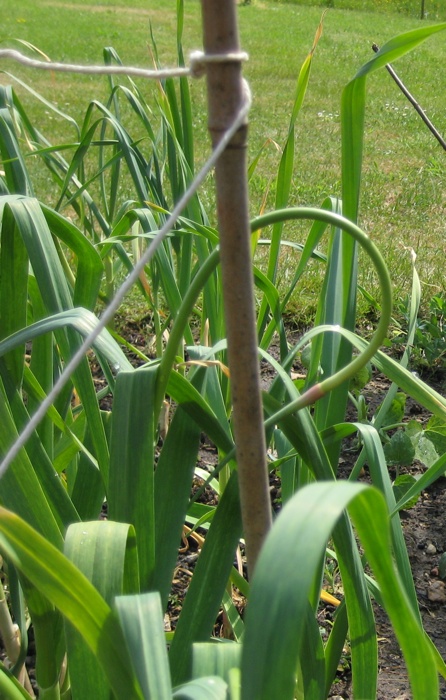
A final planting for the day occurred almost as an after thought. Shallow drills containing a scattering of seeds Cabbage Red Drumhead, Cabeza, Brooccoli Purple Sprouting Early, Kohl Rabi Azur Star, Florence Fennel Romanesco, and five Artichoke Imperial Star completed the process. Further watering with the watering can was then required.